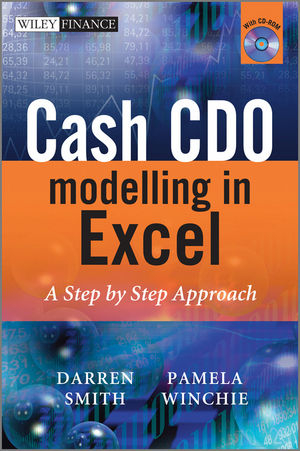
Cash CDO Modelling in Excel
John Wiley & Sons Inc (Verlag)
978-0-470-74157-3 (ISBN)
This book is an introduction to the modelling of cash collateralised debt obligations (“CDOs”). It is intended that the reader have a basic understanding of CDOs and a basic working knowledge of Microsoft Office Excel. There will be written explanations of concepts along with understandable mathematical explanations and examples provided in Excel.
About the authors DARREN SMITH, London, UK, currently heads the Credit Structuring team at WestLB. He has over 12 years' experience in the cash CDO market, and has executed numerous transactions in asset classes as diverse as loans, bonds, emerging market bonds, asset backed securities, CDOs and credit default swaps. Prior to WestLB Darren worked in CDOs at PaineWebber, UBS, and was co-head of CDOs at Dresdner Kleinwort. He has spoken at numerous conferences including the Global ABS Conference, Barcelona, and CDO Europe conferences sponsored by Opal. Darren holds a bachelor's degree in Electronic Engineering from the University of South Australia. PAMELA WINCHIE, London, UK, is currently a Managing Director at Cross Point Capital, London. Prior to this Pamela held positions as a Director in the European CDO group at Barclays Capital, and a Director in the CDO group at Dresdner Kleinwort. She has over 10 years' experience both as a cash CDO structurer and as a lawyer involved in corporate, securities and securitization law. She has modelled and structured numerous CDOs in various currencies with a range of underlying assets and has spoken at a number of conferences including the CRE-CDO Summit, London, the European CDOs & Credit Derivatives Conference sponsored by IMN and the International Structured Product Conference. Pamela holds a bachelor's degree in Mathematics and Statistics from the University of Western Ontario and a Juris Doctor from Osgoode Hall Law School.
Foreword. Acknowledgments.
1 Introduction.
1.1 To Excel or Not to Excel?
1.2 Existing Tools and Software.
2 What is a Cash CDOs?
2.1 Types of CDOs.
2.2 Description of a Cash Flow CDO.
2.3 Life Cycle of a Cash CDO.
2.4 Contribution to the “Credit Crunch”.
3 Introduction to Modelling.
3.1 Goals in Modelling.
3.2 Modelling Philosophies and Trade-Offs.
3.3 Flexibility.
3.4 Organization and Layout of a Model.
3.5 Life-Cycle Issues: Building an Adaptable Model.
4 Prerequisites to Cash Flow Modelling.
4.1 Modelling Dates.
4.2 Interest Rate Curve Modelling.
4.3 Present Value Modelling.
5 Getting Started.
5.1 Create the Input Sheet.
5.2 The Value of Labelling.
6 Modelling Assets.
6.1 Initial Asset Pool: Rep Line Modelling vs. Actual Assets.
6.2 The Collateral Sheet in the Cash Flow Model.
6.3 Modelling Defaults and Recoveries.
6.4 Amortization.
6.5 Modelling Reinvestment.
6.6 Reinvestment Cohorts.
6.7 Accounts.
6.8 Timing Models vs. Actual Timing.
6.9 Simple Warehouse Modelling.
7 Basic Waterfall Modelling.
7.1 Basic Waterfalls.
7.2 Layout and Design.
7.3 Avoiding Negative Values.
7.4 Timing Modelled vs. Actual Timing.
7.5 Liabilities Cash Flows.
7.6 Fees and Expenses Cash Flows.
7.7 Interest Waterfall.
7.8 Interest Waterfall (Available Funds after Payment).
7.9 Interest Waterfall Calculations.
7.10 Principal Waterfall.
7.11 Principle Waterfall (Available Funds after Payment).
7.12 Principal Waterfall Calculations.
7.13 Adding Over-Collaterization Tests.
7.14 Adding Interest Coverage Tests.
7.15 Technical Issues with Coverage Tests.
8 Outputs Sheet.
8.1 Purpose of the Outputs Sheet.
8.2 Collating Waterfall Outputs.
8.3 Present Value.
8.4 Duration.
8.5 Weighted Average Life and Internal Rate of Return.
8.6 Equity Analysis.
8.7 Basic Auditing.
9 Moody’s Rating Agency Methodology.
9.1 Introduction to Agency Methodologies.
9.2 The Bet Approach.
9.3 Evaluating the Collateral.
9.4 Creating the Moody’s Sheet and Related References in the Cash Flow Model.
9.5 Default Profiles.
9.6 Interest Rate Profiles.
9.7 Running the Analysis.
9.8 Variations on the BET.
9.9 2009 Methodology Update.
10 Standard & Poor’s Rating Methodology.
10.1 The S&P Approach.
10.2 Evaluating the Collateral.
10.3 Modelling Recovery Rates.
10.4 CDO Evaluator.
10.5 Default Rates.
10.6 Interest Rate Stresses.
10.7 Amortization.
10.8 Additional S&P Modelling Criteria.
10.9 Building the S7P Sheet and Related References.
10.10 Running the Stress Scenarios.
11 Advanced Waterfall Modelling.
11.1 Hedge Agreements.
11.2 Fixed Notes.
11.3 Variable Funding Notes.
11.4 Liquidity Facilities.
11.5 Interest Reserve Accounts.
11.6 Other Structural Features.
11.7 Combination Notes.
11.8 Collateral Manager Equity Analysis.
12 Maintaining the Cash Flow Model.
12.1 Adapting Your Model for Different Capital Structures.
12.2 Audit Sheet.
12.3 Debugging.
13 Advanced Structuring Issues.
13.1 Projecting Accrued Interest.
13.2 Collating Collateral Cash Flows.
14 Sourcing and Integrating Data From External Systems.
14.1 Data Requirements.
14.2 Trustee Reports.
14.3 Bloomberg.
14.4 Loan Level Information Sources.
15 Regulatory Applications of CDO Technology.
15.1 The Basel Accords.
15.2 Regulatory Capital Requirements for CDO Notes.
15.3 The Standardized Approach for CDOs.
15.4 The Internal Ratings-Based Approach for CDOs.
15.5 The Internal Ratings-Based Approach for CDOs: The Ratings-Based Approach.
15.6 The Internal Ratings-Based Approach for CDOs: The Supervisory Formula Approach.
15.7 The Internal Ratings-Based Approach: Liquidity Facilities, Overlapping Exposures, Credit Risk Mitigation and Early Amortization Features.
15.8 Supervisory Provisions.
15.9 Updates to Basel II.
16 CDO Valuation.
16.1 Introduction.
16.2 Basic Valuation Approaches.
16.3 Traditional Underwriter Analysis.
16.4 Fundamental Cash Flow Analysis.
16.5 Using Rating Agency Models.
16.6 Transition Matrices.
16.7 Conclusion.
17 In Conclusion.
Index.
| Erscheint lt. Verlag | 21.5.2010 |
|---|---|
| Reihe/Serie | The Wiley Finance Series |
| Verlagsort | New York |
| Sprache | englisch |
| Maße | 178 x 252 mm |
| Gewicht | 767 g |
| Themenwelt | Informatik ► Office Programme ► Excel |
| Wirtschaft ► Betriebswirtschaft / Management ► Finanzierung | |
| ISBN-10 | 0-470-74157-0 / 0470741570 |
| ISBN-13 | 978-0-470-74157-3 / 9780470741573 |
| Zustand | Neuware |
| Haben Sie eine Frage zum Produkt? |
aus dem Bereich


